
scripturient
adj. having a desire for writing or authorship

scripturient
adj. having a desire for writing or authorship
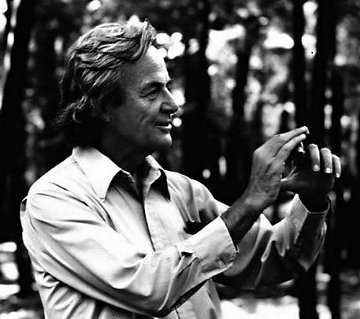
In 1982 Richard Feynman and his friend Tom Van Sant met in Geneva and decided to visit the physics lab at CERN. “There was a giant machine that was going to be rolled into the line of the particle accelerator,” Van Sant remembered later. “The machine was maybe the size of a two-story building, on tracks, with lights and bulbs and dials and scaffolds all around, with men climbing all over it.
“Feynman said, ‘What experiment is this?’
“The director said, ‘Why, this is an experiment to test the charge-change something-or-other under such-and-such circumstances.’ But he stopped suddenly, and he said, ‘I forgot! This is your theory of charge-change, Dr. Feynman! This is an experiment to demonstrate, if we can, your theory of 15 years ago, called so-and-so.’ He was a little embarrassed at having forgotten it.
“Feynman looked at this big machine, and he said, ‘How much does this cost?’ The man said, ‘Thirty-seven million dollars,’ or whatever it was.
“And Feynman said, ‘You don’t trust me?'”
(Quoted in Christopher Sykes, No Ordinary Genius, 1994.)
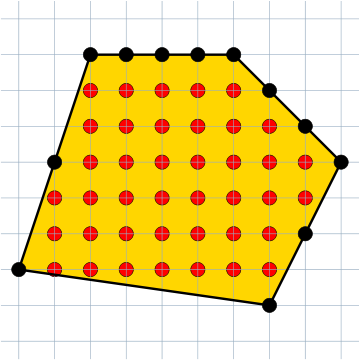
Georg Alexander Pick found a useful way to determine the area of a simple polygon with integer coordinates. If i is the number of lattice points in the interior and b is the number of lattice points on the boundary, then the area is given by

There are 40 lattice points in the interior of the figure above and 12 on the boundary, so its area is 40 + 12/2 – 1 = 45.
(Thanks, Pål.)
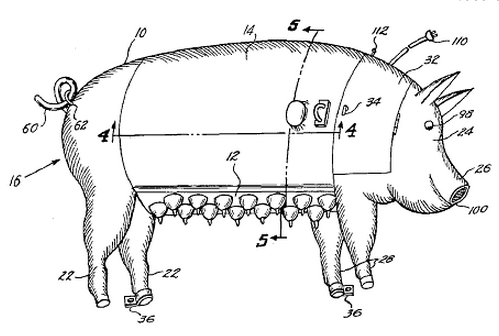
How do you feed newborn pigs when the mother has died or when they are so small or numerous that they may be crushed at feeding time? In 1961 Cora Lee Brown found a unique solution:
One of the important objects of this invention is the provision of a pig feeder designed in the form and size of an actual sow so as to simulate as much as possible the nursing environment afforded by the real animal and to thereby create a natural atmosphere for cultivating the natural eating habits and conditions of the newborn pigs.
In field tests Brown’s invention reduced the mortality rate of newborn pigs. It even plays a recording of the actual sounds of a sow at feeding time, “which operates on predetermined time schedules and is synchronized with the regulated supply of feed to the feeding tank.”
The Lord is my Shepherd; my wants are a’ kent; the pasture I lie on is growthie and green.
I follow by the lip o’ the watirs o’ Peace.
He heals and sterklie hauds my saul: and airts me, for his ain name’s sake, in a’ the fit-roads o’ his holiness.
Aye, and though I bude gang throwe the howe whaur the deid-shadows fa’, I’se fear nae skaith nor ill, for that yersel is aye aside me; yere rod and yere cruik they defend me.
My table ye hae plenish’t afore the een o’ my faes; my heid ye hae chrystit wi’ oyle; my cup is teemin fu’!
And certes, tenderness and mercie sal be my fa’ to the end o’ my days; and syne I’se bide i’ the hoose o’ the Lord, for evir and evir mair!
— William Wye Smith, The New Testament in Braid Scots, 1904

The Pont Neuf is the oldest bridge across the Seine.
Pont neuf means “new bridge.”
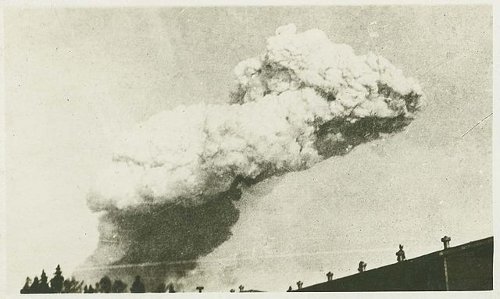
On Dec. 6, 1917, an overnight express train bearing 300 passengers was approaching Halifax, Nova Scotia, when an unexpected message arrived by telegraph:
“Hold up the train. Ammunition ship afire in harbor making for Pier 6 and will explode. Guess this will be my last message. Good-bye boys.”
The train stopped safely before the burning French cargo ship Mont-Blanc erupted with the force of 2.9 kilotons of TNT, the largest manmade explosion before the advent of nuclear weapons.
The blast killed 2,000 residents, including train dispatcher Vince Coleman. He had remained at work in the telegraph office, sending warnings, until the end.
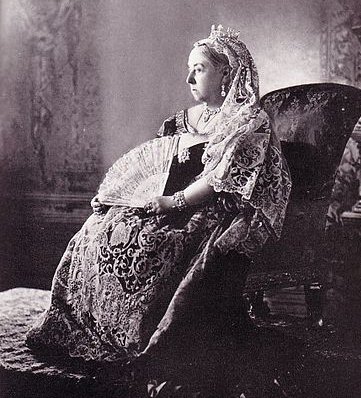
From the diary of Wilfrid Scawen Blunt, May 1, 1900:
To the Danes to see Lady Lytton, travelling there with Betty Balfour, who told amusing stories about Ireland, one being of a voyage the Queen [Victoria] had made in her yacht. The Queen used to be a good sailor, but is disturbed now if it is at all rough and likes the doctor to sit with her in the cabin and look after her. It came on to blow and a wave struck the ship rather roughly, which alarmed and made her indignant. ‘Go up at once,’ she said, ‘Sir James, and give the Admiral my compliments and tell him the thing must not occur again.’

When Napoleon left France for Elba, his supporters wore violets as a secret sign of their allegiance. This 1815 colour print by Jean-Dominique Etienne Canu, Le Secret du Caporal La Violette, conceals images of the exiled emperor, his wife, and his son. Where are they?
“What is patriotism but the love of the good things we ate in our childhood?” — Lin Yutang